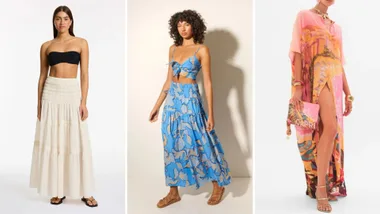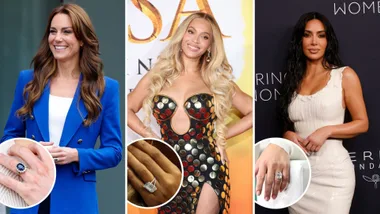When, in the same morning, you learn that celebrities are being paid to appear as front row guests during Fashion Week while the young models walking those shows are not getting paid for the long hours they slog, you’re not really sure how to feel. Disgusted? Sad?
French-born, London-based fashion designer Nicole Fahri decided to speak out about the well-known (but never talked about) fact that fashion houses will pay tens of thousands of dollars for a celebrity to make an appearance at their fashion shows.
In pictures: Mirada Kerr-ves – Australia’s sexiest supermodel
“What do they show you in the papers after a fashion show? Not the clothes, but the celebrities who are being paid to sit at the show,” she told the Sunday Telegraph’s Stella magazine.
Fahri says she has never paid a celebrity to attend one of her shows, and never will, citing it as “abominable”.
Whether it is abominable that celebrities are now attending shows for financial reasons, and not just to express their love of the latest pretty skirts and new silhouettes is a matter of opinion.
What is unequivocally detestable however, is that designers and design houses are making models — some under the age of 18 — work for free while they pay celebrities vast sums of money to be a part of the same show.
While the fashion weeks in question are London Fashion Week (paid celebrities) and New York Fashion Week (unpaid models), and as far as we know the two do not cross over, it is poignant because these events not only coincide during fashion’s most important month of the year, but they are both accepted and expected within the fashion industry today.
Jenna Sauers, a previous model herself and now a fashion writer for Jezebel, would like this to change.
She came across the Tumblr acocunt of Hailey Hasbrook, the 17-year-model who documented her daily working schedule with Marc Jacobs candidly and honestly on her blog.
Hasbrook reported on her 30 hours of work for Jacobs during New York Fashion Week, her 4.30am finish times and then her payment in trade (several items of clothing) instead of actual cash.
Sauers wrote about Hasbrook’s experience on Jezebel, outing Jacobs for his lack of responsibility, and drawing attention to his second violation of CFDA guidelines in as many weeks — the first being his casting of models under the age of 16 in his most recent New York show and the second being his insistence that models under the age of 18 work past midnight.
All the while celebrities are being paid unthinkable amounts of money, not unthinkable amounts of clothes, to watch these shows.
Unfortunately this is common practice within the fashion industry and is not dissimilar to the treatment of interns throughout the media industry.
Interns work hard, invest long hours, risk mental breakdowns and endure bitchy employers all for no pay, to gain all-important ‘experience’.
We’ve all heard it: “A million girls would kill to be where you are. You should feel lucky to be there.”
Meanwhile, a single fashion shoot (for which the intern will usually spend long hours over many evenings preparing), and sometimes even just the car they hire as a background prop, can cost an average month’s salary. Something isn’t right there.
Sauers is also a member of The Model Alliance, a not-for-profit organisation founded by Sara Ziff that aims to put a stop to the “modelling industry’s systemic abuses of its workforce”.
By giving models in the US a voice in their workplace, they endeavour to improve their basic working conditions in what is now an almost entirely unregulated industry.
When Jacobs — a successful designer who has the money and clout to support what the Model Alliance and the CFDA both strive for — decided to disregard the very few guidelines put in place to protect venerable models, it is inarguably irresponsible and fundamentally disappointing.
His defence of his actions a few hours later on Twitter — he stated “models are paid in trade. If they don’t want to work with us, they don’t have to” — was equally reprehensible.
This seemingly dumbfounding ideology may hold up against newer brands that are fighting to stay afloat within the constant seismic shifts of the fashion industry.
But as Sauers pointed out, LVMH, the conglomerate that owns the brand Marc Jacobs, made a net profit of $4.13 billion last year. Jacobs has the money to pay his models, so why doesn’t he?
Since this story was brought to light, all posts on Hasbrook’s Tumblr have been taken down, except for one that appears to be her public apology to Jacobs and her response to Sauers article.
There is no doubt that this is the work of her modelling agency, fighting to fix the mess that will probably tarnish the Hasbrook’s working relationship with Jacobs.
Instead of defending Hasbrook, and her fellow models on their books, the agency found it much easier to bow down to the conglomerates and the famous fashion designers that front them.
Ultimately there is a possibility she may not be booked again, and not just by Jacobs but by other designers who would rather the world didn’t know that they also don’t pay their models.
Without fearless fashion journalists — who can take on Jacobs and others without worrying they’ll never be invited to an important show again — any hope of changing how the industry treats its models is futile.
In pictures: Supermodels who still look super
This piece started out as a simple report of some of yesterday’s more important breaking news, but has turned into a semi-salute to writers, and everyone else out there who is willing to put small steps into the marathon it will take to make some changes around here. Are you with me?
Note: The Australian fashion industry always pays models for their work, and has strict guidelines regarding the treatment of underage models.
Your say: Do you think designers should be allowed to force young girls to work for free?
Video: Marc Jacobs at New York Fashion Week











